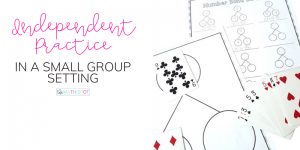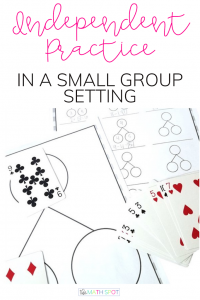This post contains affiliate links. This means that when you make a purchase, at no additional cost to you, I will earn a small commission.
My third-grade teacher always told us
Practice doesn’t make perfect. Practice makes permanent!
When we were practicing our cursive lettering he wanted us to be sure not to get sloppy and practice incorrectly- the habits we formed during practice would be hard to break!
The same is true of our students when it comes to their independent math practice!
Try This!
This quick-to-implement strategy solves this problem when it comes to math centers and independent practice.
- Set aside small group math time FOR independent practice! If you have ever thought to yourself “They could do it at the small group table but then when they went back to their seat they fell apart!” then you have students who need to practice independently… with your support.
- Position yourself so you are at the “hub” of the activity. For me, this meant staying at the small group table. Position your students in their own spaces nearby. For me, this meant that while I was at the small group table one student worked on the windowsill nearby, one student worked on a small rug next to the table, another student worked at my desk and another student stayed at the small group table. I had a VERY small intervention space but this is what worked for me. Any individual nearby workspaces will work.
- Keep the activity materials at your table. For example, if your students need to roll a dice during the activity, keep the dice at your table. If they are selecting two playing cards to compare, keep the cards at your table. If there is a spinner involved… you get the picture!
- Your students will come to you to roll dice, grab cards, spin the spinner, etc. and will move back to their space to do the actual math.
Why Does It Work?
When you employ this strategy you will get to check-in, frequently, with your students as they are working. You can catch any misconceptions as soon as they happen so that your students aren’t practicing incorrectly over and over.
And, as a bonus, your students are getting up and moving after every single problem. They may be moving only a few feet but the movement gives your students’ bodies the break that they need while practicing a task!






